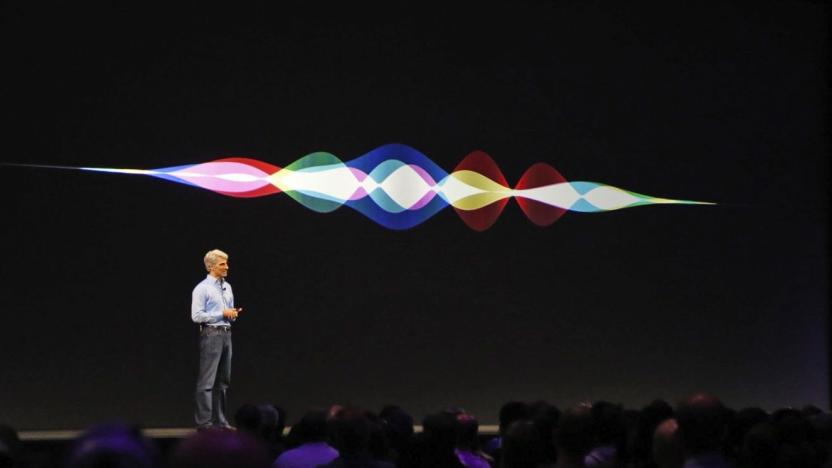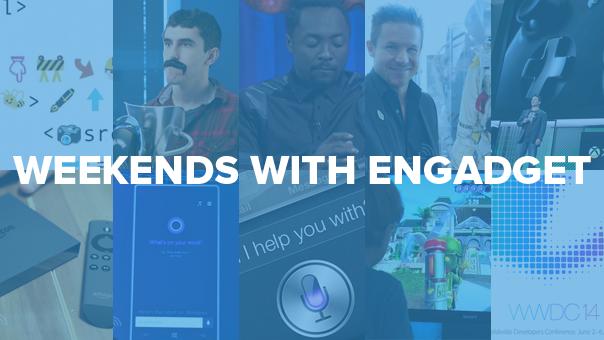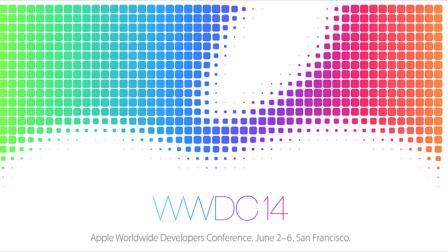Apple Worldwide Developers Conference
Latest

How Apple reinvigorated its AI aspirations in under a year
At its WWDC 2017 keynote on Monday, Apple showed off the fruits of its AI research labors. We saw a Siri assistant that's smart enough to interpret your intentions, an updated Metal 2 graphics suite designed for machine learning and a Photos app that can do everything its Google rival does without an internet connection. Being at the front of the AI pack is a new position for Apple to find itself in. Despite setting off the AI arms race when it introduced Siri in 2010, Apple has long lagged behind its competitors in this field. It's amazing what a year of intense R&D can do.

Apple boosts the MacBook line's performance with Kaby Lake processors
Apple's 2017 laptop lineup will be a bit speedier than last year's offerings, the company announced at WWDC 2017 on Monday. The MacBook will receive the seventh-generation "Kaby Lake" processors from Intel. Specifically, they'll come equipped with a new i7 chip ranging in speed from 1.3GHz up to 3.6GHz. Its new SSD will be both twice as fast as the current model and support double the memory.

Apple's iWork for iCloud now lets you collaborate on projects with 100 friends
If you're using Apple's iWork for iCloud to get stuff done, now you can collaborate on projects with even more people. Before if you wanted to get your co-workers input on your big plans for the company retreat (Laser Tag definitely promotes synergy) you could only have 50 contributors. Now 100 people can work on the same Keynote, Numbers or Pages file at once, and those projects can also be a lot larger. Previously you were limited to 200MB per file, with a 5MB cap for included images. Now there's 1GB of space to fill with details about your group-cooking class plans, complete with images of up to 10MB each -- that's a lot more fancy dessert photos

Dear Aunt TUAW: Are pixels doomed?
Dear Aunt TUAW, Today I've been reading rumors of new iPhones all over the interwebs. Everyone's talking about 3x resolutions and 1704 x 960 displays. Help me, Aunt TUAW -- is my Retina display doomed? Thanks, Your Nephew David X. Dear David, Your Retina iPhone is not doomed. Apple's Retina technology packs in tight pixels for resolution excellence and has been a certain winner. Uncle Rich's coverage of what Retina means is a must-read if you're interested in learning more about the subject. Today's rumor suggests that Apple might pack a new iPhone with even more pixels than ever. Auntie is not going to take a position one way or the other on whether it makes sense to introduce another resolution style. All the developers she talked with this morning reacted with horror tinged with a certain intrigue when approached on the matter. Here are some basic facts... If the iPhone 5 had used a non-retina display, its screen would have presented 181,760 pixels at a time, a quarter of the 727,040 it actually uses and a ninth of the 1,635,840 rumored pixels for the iPhone 6. But compared to a current iPad air with its 3,145,728 pixels that's just pocket change. What developers are particularly worried about is having to stuff yet another image resolution into their already bloated applications. With the baseline iPad air packing only 16 GB, and apps having to already support image assets for non-retina and retina distributions on both tablet and phone families, it's hard to think that Apple would force yet another set of images into everyone's distributions. Auntie is hoping that Apple will introduce native vector support for the "UIImage" class in iOS 8. Describing images as rescalable vectors would massively shrink those app bundles. Sure it takes a bit more processing time to scale and display vectors than to present simple images, but they'd provide a great way to design images that would automatically scale without blurriness no matter what kind of screen was thrown at them. In fact, popular developer icon resource Glyphish just announced a "Complete" bundle with full vector icon support, to scale up the art as needed. (Photographic images would still pose an issue, and they're never going to go away, unless Apple throws in some kind of magic fractal compression solution as well.) Auntie suggests you wait a few weeks and then poke a developer after WWDC. The image APIs introduced this year will probably deliver some strong hints as to whether the rumored August product launches will stretch the definition of Retina or not. Hugs, Auntie T.

Weekends with Engadget: Amazon's Fire TV, Microsoft announces Windows Phone 8.1 and more!
Welcome to Weekends with Engadget, a quick peek back at the top headlines from the past seven days -- all handpicked by the editors here at the site. For even more action, subscribe to our Flipboard magazine!

WWDC for fun and tickles
It's that time of year again! This morning, when Apple announced its WWDC dates and opened its new lottery system, potential attendees started going crazy attempting to book flights and hotel rooms in the hope they'd get lucky. This morning thousands of developers signed up for a chance to pay $1600 (not to mention those hotel and flights) to participate in one of the most valuable -- but exclusive -- events on the Apple social calendar. Some tell me they're planning to travel regardless of whether they do or do not win that golden ticket. With a major swell in third party conferences and landing zones, WWDC has spilled out from the walls of Moscone into a much wider community event. Think of Burning Man, but with better dressed attendees... (If you like, you can skip the word "better" in that sentence.) Some developers I talked to this morning were busy contemplating a startup selling souvenir badges. "Why feel outcast when you can purchase a fake attendee thing to hang around your neck. You can walk around SF looking like a real hipster!" I don't believe they were being entirely serious. Meanwhile, others were busy carefully dissecting the new announcement art. Although we at TUAW still think it looks a bit like a horse's behind, we're curious about the suggestion it creates of display technology and pixels. Very intriguing if so. What do you think of the artwork? Any secret clues? Share your thoughts in the comments and tell us what you think about the new WWDC sign up system. Love it? Hate it? Fear it? Also, if you have any third party events you're organizing or planning to participate in, please drop us a line! We'd love to hear about it.

Dev Juice: Using your tech support incidents
I find it a constant puzzle as to why so relatively few developers take full advantage of technical support incidents. Two incidents are included with your annual developer license. Additional incidents cost just US$50 each, which you buy in two-packs. Using Incidents You'd think that at just $50, a price that's lower than most billable hours, developers would be all over support but, many never end up using them: Others carefully hoard them for the most pressing cases: Resolution Tech incidents don't always have happy endings. In some cases, they get back-burnered without a satisfactory resolution. Other developers report that they have never experienced more than a 48-hour turnaround. Incidents may be credited back if it's discovered that an issue: was due to an Apple bug, should be handled as a feature request, needed to be passed off to another department or simply could not be resolved: While you were initially charged a technical support incident for this request, we have assigned a replacement incident back to your account. Developer Support To use an incident, go to the Apple Member Center and click the Technical support button. The website lists all available support incidents on a per-membership basis. Click the Request Support button to use an incident, or Buy More to add new ones. A panel at the bottom of the page lists your tech support history. When submitting a new request, you provide background on your hardware setup, the issue you're working on and the steps to reproduce it. Beta Software Do note that DTS does not offer tech incidents for beta software. Instead, you should visit the Apple dev forum site and hope that you get some help there. (Most common support response at dev forums: "Please file a bug report or feature enhancement.") Other Avenues WWDC labs in some ways can be seen as a weeklong unlimited tech incident, should you be fortunate enough to attend, and do take note of the technical evangelists for topics. You can often reach out to them outside of the normal tech incident channels. Just be aware that they'll help guide you to appropriate technologies; they cannot and will not help you debug your code. Want to share your tech support stories? Got other suggestions for finding Apple-supplied help? Drop a note in the comments and share.

Apple adds free iBook offer to Apple Store app
At the beginning of August, Apple launched a new free-content program in their Apple Store app, kicking things off with a free download of Color Zen. Today the latest piece of free content has been released, and it should make parents of small children very happy. The over-the-air update allows users to download Margaret Wise Brown's children's book Away in My Airplane as a free iBook. Apple retail employees were told about the free book release this morning in a note informing them to use the release to promote iBooks and the iBookstore with customers in their stores. The book offer expires on August 28th, and is only available in the United States, United Kingdom, France, Italy and Sweden according to a source for 9to5mac.com. iBooks was announced as a major part of the upcoming OS X Mavericks release at this past June's WWDC event. It is clear that Apple is working hard to get users familiar with the app before it officially becomes a new addition to their Macs in the fall.

The Loop looks at OS X Mavericks
Perhaps this post should have been titled "The Beard looks at OS X Mavericks," since the subject is about an article written by veteran Apple blogger Jim Dalrymple on his Loop Insight blog. Dalrymple's opinions are highly valued by Apple, and he received a 13-inch MacBook Pro and a copy of OS X Mavericks to evaluate for the blog. His blog post is a first look at the beta Mac OS, and he's actually quite happy with what Mavericks has to offer. Dalrymple pretty much decided that he'd use the Mavericks machine as his only work computer, doing his blogging, tweeting and all other work under the beta software, as "this was the only way to truly evaluate what the operating system could do." To begin with, Dalrymple was pleased to find that all of his apps worked under Mavericks. He was happy with the addition of Finder tabs (multiple tabs in one Finder window), and found Finder tags "a lot more useful than website tags." iCloud Keychain -- which syncs passwords stored on your Mac with any iOS device you choose -- was a feature that Dalrymple really finds to have a lot of potential, as it can ease password access from within Safari on iOS. Likewise, Dalrymple is happy with OS X Mavericks' Notifications, which now allow one-click replies without needing to launch an app. But he singled out Maps in Mavericks for special love -- one of his favorite features is the ability to take directions created with Maps on the Mac and send them to an iPhone or iPad with a click. It's a fun post by one of the top Apple bloggers and well worth a read. While Dalrymple can't divulge any new features due to the Apple NDA, he does a great job of explaining how the features that were touted during the WWDC 2013 keynote work in real life.

Apple opens iWork for iCloud beta to registered developers
One part of Monday's WWDC 2013 keynote that seems to have received short shrift in the discussions of updated products is iWork. During the keynote, iWork for iCloud -- a browser-based version of Apple's office suite -- was discussed along with comments about the iOS versions of the suite. Now Apple has followed up the announcement by opening a beta of iWork for iCloud to registered developers. While the browser-based iWork for iCloud is meant to work on Mac or PC in just about any browser, developers opening the beta web apps in Chrome are greeted with a message saying "Your browser isn't fully supported. For the best Pages/Keynote/Numbers for iCloud experience, use the latest version of Safari." For those who have been using the current version of iWork and saving documents to iCloud, all of the saved documents are immediately available for test. The web suite will be released to the world later this year; at the present time, developers can try out the apps by logging in at beta.icloud.com.

So you've been Sherlocked: AirParrot developers respond to new Mavericks features
On Monday, Apple introduced OS X Mavericks, their next-generation operating system for Macs. One feature Apple demoed on stage enables users to use an HDTV as an extra monitor, courtesy of Apple TV and AirPlay connectivity. If that feature sounds familiar, you may already be an AirParrot customer. The US$9.99 app allows you to stream your screen or individual windows to Apple TV and it also offers extra screen support. The app's popular extended desktop features have been around for a while. After Monday's announcement, we contacted Sidney Keith of Squirrels to get his reaction to the Mavericks feature. Today, he provided the following, thoughtful response. We're continuing to innovate and develop at our own pace. Just because Apple released one of our features as its own doesn't mean we quit. We're still striving for quality applications that solve our customers and users needs. Honestly, we're glad Apple finally caught up. It gives us that much more motivation to innovate and create cooler applications that users want and need. Software is about progress, and that's what this is going to give us. Not only do we have the motivation to keep innovating, we now have the opportunity and obligation to help those that can't or won't upgrade to 10.9. We have a large and loyal customer base that we'll continue supporting. We don't plan on dropping support for 10.6, even though we've now seen three major releases since then, and not everyone is as loyal to Apple as we may think. Upgrades can be costly for institutions and businesses that have hundreds of systems that need to be upgraded. We're here for those users, and we're here for the ones that don't trust the first iterations of Apple products. Whatever the reason for not upgrading, we have their back. Apple has a global audience to attend to, and while we also have users all around the globe, our feature set is much more focused. We're able to focus solely on one group of features instead of an entire operating system. While Apple might add a feature, it's likely they'll not change that feature significantly in any future releases. We saw the addition of AirPlay desktop mirroring in OS X 10.8, but that feature hasn't changed since its initial release-roughly a year since the beta. We've got the ability to focus our entire teams attention on that one specific feature if we need to. That's something you'll be seeing over the next few months. We'll be doing a lot of innovation and creation in this area, and while we hope Apple doesn't steal our new features, we know it's inevitable. It's almost an honor. If you want to see what Apple's going to to include AirPlay-wise at WWDC 14, you can probably bet our next few releases will be a preview. Squirrels is also the developer of the Reflector app, which nearly all of us at TUAW have purchased. It allows you to stream AirPlay to your Mac or PC. Note: in case you're wondering what "Sherlocked" refers to, here's a definition. Looking for other examples? Here's another for your delectation. No downeys, millers, cumberbatches, lauries, bretts, etc. were hurt in the preparation of this article.

iOS 7's game controller support could be a real game-changer
Of all of the features of iOS 7 that have been talked about since Monday's WWDC 2013 keynote, probably none has more potential impact than the item circled in blue on the image above -- MFi game controller support in the iOS 7 SDK. Jeff Blagdon at The Verge took a closer look at what this means for Apple fans, and possibly for the gaming world as a whole. MFi means "Made For iPhone/iPod/iPad," and refers to officially licensed add-ons that meet specifications set forth by Apple. The company is now adding support for controllers to the SDK, making it easy for third-party game controller manufacturers to create hardware that Apple can "bless." Developers benefit, since they know that their games will work with any of the approved game controllers. But Blagdon brings up a much bigger point in his post. Since Apple added AirPlay mirroring to iOS devices with iOS 5, anyone with a US$99 Apple TV can easily blast mobile gameplay to their HDTV. Blagdon says "with API-level support for third-party game controllers, who is going to stop Apple from waltzing into the home console market?" Apple already controls the handheld gaming market, and Blagdon notes that the new 16 GB iPod touch and Apple TV cost just US$328 -- less than the $399 Sony PS4 announced yesterday or the $499 Microsoft Xbox One. Apple could easily begin to make the dedicated home gaming console obsolete.

DevJuice: Does WWDC need a lottery system?
WWDC sold out in just minutes this year. As iOS developer Josh Avant put it, "Next year, tickets are going to sell out before they even go on sale." Many developers were greeted by server errors, failed purchases and the "Sorry, tickets are sold out" banner. Others, like Daniel Jalkut of Red Sweater Software, were able to place an order. In the end Jalkut decided to cancel his ticket, stating, he was "[v]ery conflicted, but it ended up feeling too exclusive for me." In a move that was seen as a boost to fairness, developers were given a day's warning about sale time. This enabled people around the globe to set their alarms and schedule their visit to Apple's developer site. Unfortunately, the high demand for the "golden" tickets meant that distribution was both chaotic and random. The overloaded system presented bugs, as reported by various parties on Twitter. "I never once got anything but an error page," said developer David Green. "Apple seriously needs to change how they handle WWDC tickets, that went beyond unfair and into untenable." "It timed out on me when I submitted the purchase," agreed developer Scott Yelich. So why not switch to a less intense lottery system? Sure, the results are still random, but distributing purchase requests over a week or month surely would avoid the technology-based limits created by so much demand at a single moment (not to mention sleepless nights caused by time zone differentials). Did you snag a ticket? Or were your attempts unsuccessful? Drop a note in the comments and share your story. Think WWDC needs fixing? Here are TUAW's proposals from last year.

Apple announces WWDC video feeds for developers
Although the social component and Apple-staffed labs are two important reasons for developers to attend WWDC, early access to tech briefings has long been a motivating force for buying that expensive ticket. Today, it looks like Apple introduced a major change into their oversubscribed WWDC demand by offering video session feeds for all registered devs -- that appear to be during the conference. On the "more" page, Apple writes: "Can't make it to WWDC? We'll be posting videos of all our sessions during the conference, so Registered Apple Developers can take advantage of great WWDC content." This is really great news, if I'm reading that right as "during the conference" referring to when they post versus "videos of all our sessions during the conference" referring to what they post. If so, what this does is ensure that devs, no matter what time zone and budget they're working with, will have quick access to the same conference material as attendees. Sure, WWDC is going to sell out quickly again this year, but at the same time, many people who might have been camping out overnight with a credit card and a phone -- especially those overseas -- will have a great alternative track option. Between the videos and the pre-announced registration time, it looks like Apple has made important and welcome changes that respond to the realities of their post-iPhone / iPad world. Hat tip fpillet

Auto manufacturers slow to adopt Siri Eyes Free
Remember the hoopla at last year's WWDC when Apple announced Siri Eyes Free? The feature was designed to use a car's onboard voice-recognition hardware to process voice input and pass it along to Apple's Siri. At this point in time, according to an article on Wired, only GM has actually implemented the feature and two others have disclosed plans to offer Siri Eyes Free. GM made Siri Eyes Free available on the entry-level Sonic and Spark vehicles through the MyLink infotainment system, which uses the iPhone to supply just about all the content available -- music, navigation and communications. But two low-end vehicles from one manufacturer don't spell success for Siri Eyes Free. Fortunately, Honda is planning on adding the feature to new vehicles by this summer, and Mercedes-Benz will add Siri Eyes Free integration with an add-on accessory called the Drive Kit Plus for iPhone within a week. Wired's Doug Newcomb notes that the issue isn't with the technology, but rather with the long product lead times with auto manufacturers and difficulties in making changes to production vehicles. That's not to say that it's easy to integrate Siri with a car; Steve Witt of Dice is quoted as saying "When you have two competing [voice recognition] systems, I don't believe it's going to be seamless." Dice was testing Siri Eyes Free with an onboard voice recognition system and said, "The car's radio gets confused." Still, with the long lead times to get integration into a car infotainment system -- often four to five years -- it may be a while before Siri Eyes Free is commonplace in new vehicles.




